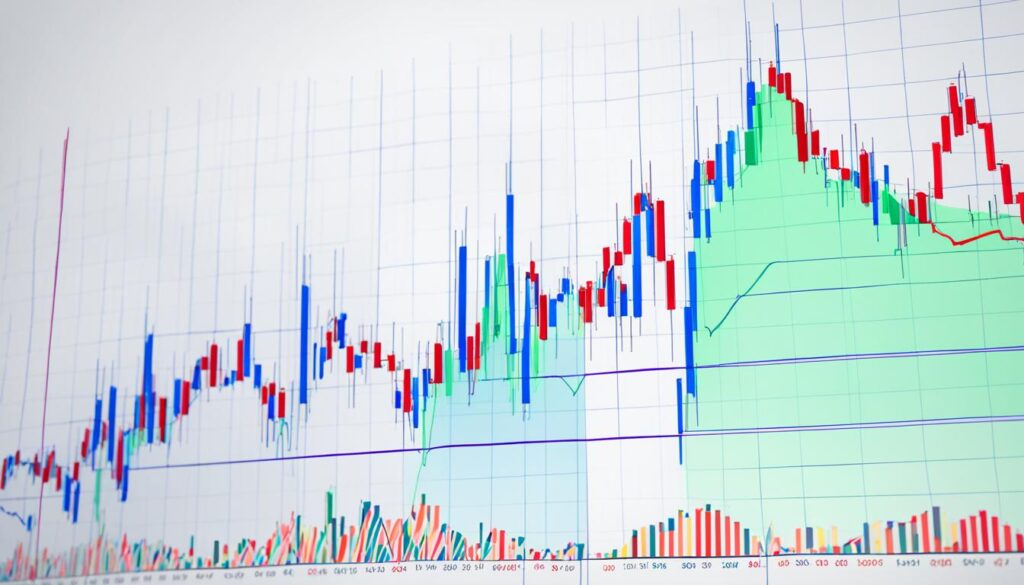In the fast-paced world of financial markets, success can often seem elusive. However, by mastering professional trading strategies, you can elevate your trading game and unlock the path to financial success. In this article, I will guide you through the secrets of professional traders, providing valuable insights and techniques that can transform your trading journey.
Professional trading strategies are not just about taking random trades; they involve a systematic approach backed by extensive knowledge and experience. By learning from the pros, you can gain a deeper understanding of market dynamics and develop the skills necessary to navigate the complex landscape of trading.
Key Takeaways
- Mastering professional trading strategies is crucial for achieving financial success in the trading world.
- Learning from experienced traders can provide valuable insights and techniques to elevate your trading game.
- Professional trading strategies involve a systematic approach backed by extensive knowledge and experience.
- By applying professional trading strategies, you can navigate the complex market landscape with confidence and increase your chances of success.
- Continuously learning and adapting your trading strategies based on market conditions is key to long-term success.
With the right mindset and dedication to learning, you can unlock the secrets of professional trading strategies and pave the way to financial success. So, let’s dive in and explore the world of professional trading strategies together!
The Importance of Effective Risk Management
Effective risk management is a crucial aspect of professional trading strategies. As traders, we all strive to minimize losses and maximize profits to achieve long-term success in the financial markets. To accomplish this, it is essential to have a comprehensive risk management plan in place.
Risk management involves setting clear risk parameters that align with your trading strategy and risk tolerance. This means determining the maximum amount of capital you are willing to risk per trade and sticking to it, even in the face of potential losses. By defining your risk limits, you can protect your trading capital and avoid emotionally-driven decision-making.
One powerful tool in risk management is the use of stop-loss orders. These orders automatically close out a trade when a specific price level is reached, limiting the amount of loss you could potentially incur. By implementing stop-loss orders, you can protect your downside and prevent a small loss from turning into a catastrophic one.
Diversification is another important risk management technique. By spreading your investments across different asset classes or markets, you reduce the impact of a single trade or event on your overall portfolio. Diversification helps mitigate the risk of significant losses by ensuring that a single setback doesn’t have a disproportionate effect on your trading capital.
Key Risk Management Strategies:
- Set clear risk parameters that align with your trading strategy and risk tolerance.
- Utilize stop-loss orders to automatically close out trades when specific price levels are reached.
- Diversify your portfolio to reduce the impact of a single trade or event.
By implementing sound risk management techniques, you can protect your capital and increase your chances of success in the financial markets. Remember, professional trading strategies prioritize risk management alongside profit maximization.

Next, we will explore the world of technical analysis and chart patterns, providing valuable insights into spotting market trends and making informed trading decisions.
Technical Analysis and Chart Patterns
When it comes to professional trading strategies, technical analysis and the identification of chart patterns play a crucial role. By utilizing various technical analysis tools, traders can gain valuable insights into market trends, support and resistance levels, and potential entry and exit points. This analysis enables traders to make more informed trading decisions and increase their profitability.
Technical analysis involves studying historical price and volume data to identify patterns that can help predict future market movements. Chart patterns, in particular, provide traders with visual representations of market behavior and can indicate possible reversals or continuations in price trends.
Identifying Chart Patterns
There are several common chart patterns that traders often look for:
- Triangles: Triangles are formed when the price moves within a converging pattern, indicating a potential breakout in either direction.
- Head and Shoulders: This pattern consists of a higher peak (the head) between two lower peaks (the shoulders), signaling a potential trend reversal.
- Double Tops/Bottoms: Double tops occur when the price reaches a resistance level twice, indicating a potential downward reversal. Conversely, double bottoms occur when the price reaches a support level twice, signaling a potential upward reversal.
By recognizing these chart patterns and understanding their implications, traders can make more informed decisions about when to enter or exit trades, effectively managing their risk and increasing their chances of success.

The Role of Fundamental Analysis
Fundamental analysis is an essential aspect of professional trading strategies. Incorporating fundamental analysis into the decision-making process allows traders to consider various factors that can influence market movements. These factors include staying updated with market news, monitoring economic indicators, and thoroughly examining financial statements of companies.
By analyzing these fundamental factors, traders gain a deeper understanding of the true value of securities, enabling them to make more accurate predictions about market movements. Fundamental analysis helps traders identify undervalued or overvalued stocks, assess the financial health of companies, and gauge the potential impact of economic and industry trends on the market.
Integrating fundamental analysis into trading strategies provides traders with a holistic view of the market and helps them make informed decisions based on solid data and insights. By combining fundamental analysis with other technical indicators, traders can effectively identify opportunities, mitigate risks, and optimize their trading performance.
FAQ
What are professional trading strategies?
Professional trading strategies are techniques used by experienced traders to achieve financial success in the trading world. These strategies involve effective risk management, technical analysis, and fundamental analysis.
Why is risk management important in trading?
Risk management is crucial in trading because it helps minimize losses and maximize profits. By setting clear risk parameters, using stop-loss orders, and diversifying portfolios, traders can protect their capital and increase their chances of success.
What is technical analysis and how does it relate to trading?
Technical analysis is a method used by traders to analyze market trends, support and resistance levels, and potential entry and exit points. By studying chart patterns such as triangles, head and shoulders, and double tops/bottoms, traders can make more informed trading decisions and increase their profitability.
What is the role of fundamental analysis in trading?
Fundamental analysis is an important component of trading strategies. It involves considering factors such as market news, economic indicators, and financial statements of companies. By analyzing these fundamental factors, traders can gain a deeper understanding of the underlying value of securities and make more accurate predictions about market movements.
Source Links
Disclaimer
All information on this website is of a general nature. The information is not adapted to conditions that are specific to your person or entity. The information provided can not be considered as personal, professional or legal advice or investment advice to the user.
This website and all information is intended for educational purposes only and does not give financial advice. Signal Mastermind Signals is not a service to provide legal and financial advice; any information provided here is only the personal opinion of the author (not advice or financial advice in any sense, and in the sense of any act, ordinance or law of any country) and must not be used for financial activities. Signal Mastermind Signals does not offer, operate or provide financial, brokerage, commercial or investment services and is not a financial advisor. Rather, Signal Mastermind Signals is an educational site and a platform for exchanging Forex information. Whenever information is disclosed, whether express or implied, about profit or revenue, it is not a guarantee. No method or trading system ensures that it will generate a profit, so always remember that trade can lead to a loss. Trading responsibility, whether resulting in profits or losses, is yours and you must agree not to hold Signal Mastermind Signals or other information providers that are responsible in any way whatsoever. The use of the system means that the user accepts Disclaimer and Terms of Use.
Signal Mastermind Signals is not represented as a registered investment consultant or brokerage dealer nor offers to buy or sell any of the financial instruments mentioned in the service offered.
While Signal Mastermind Signals believes that the content provided is accurate, there are no explicit or implied warranties of accuracy. The information provided is believed to be reliable; Signal Mastermind Signals does not guarantee the accuracy or completeness of the information provided. Third parties refer to Signal Mastermind Signals to provide technology and information if a third party fails, and then there is a risk that the information may be delayed or not delivered at all.
All information and comments contained on this website, including but not limited to, opinions, analyzes, news, prices, research, and general, do not constitute investment advice or an invitation to buy or sell any type of instrument. Signal Mastermind Signals assumes no responsibility for any loss or damage that may result, directly or indirectly, from the use or dependence on such information.
All information contained on this web site is a personal opinion or belief of the author. None of these data is a recommendation or financial advice in any sense, also within the meaning of any commercial act or law. Writers, publishers and affiliates of Signal Mastermind Signals are not responsible for your trading in any way.
The information and opinions contained in the site are provided for information only and for educational reasons, should never be considered as direct or indirect advice to open a trading account and / or invest money in Forex trading with any Forex company . Signal Mastermind Signals assumes no responsibility for any decisions taken by the user to create a merchant account with any of the brokers listed on this website. Anyone who decides to set up a trading account or use the services, free of charge or paid, to any of the Broker companies mentioned on this website, bears full responsibility for their actions.
Any institution that offers a service and is listed on this website, including forex brokers, financial companies and other institutions, is present only for informational purposes. All ratings, ratings, banners, reviews, or other information found for any of the above-mentioned institutions are provided in a strictly objective manner and according to the best possible reflection of the materials on the official website of the company.
Forex/CFD trading is potentially high risk and may not be suitable for all investors. The high level of leverage can work both for and against traders. Before each Forex/CFD investment, you should carefully consider your goals, past experience and risk level. The opinions and data contained on this site should not be considered as suggestions or advice for the sale or purchase of currency or other instruments. Past results do not show or guarantee future results.
Neither Signal Mastermind Signals nor its affiliates ensure the accuracy of the content provided on this Site. You explicitly agree that viewing, visiting or using this website is at your own risk.


